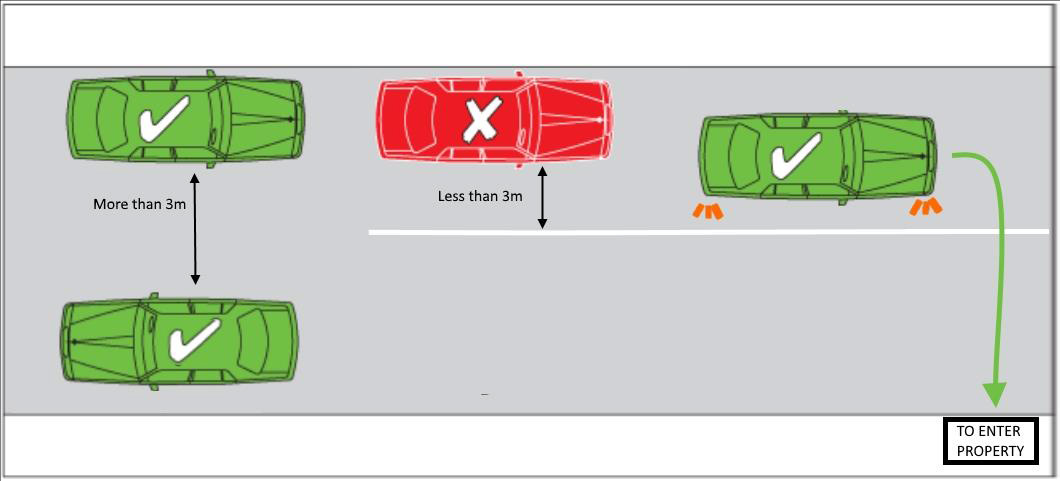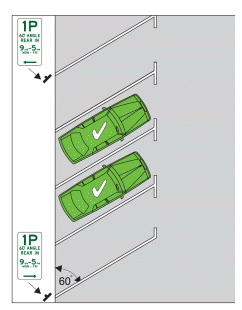General parking tips for Redlands Coast
There is a wealth of public transport to get you to and around the Redlands Coast region.
However, if you do decide to drive, there are many places to park. You must be careful to observe the parking signage for each location, as various restrictions apply.
Below are some general parking rules for Redlands Coast and parking guides for specific areas.
Parking Areas
Check whether you’re parked within a specific traffic area – Maps of Redlands Coast parking areas.
Residential Parking
A question that is commonly asked of Council is: How do I know if a vehicle is parked illegally near or across my driveway?
Drivers must not park across a driveway or prevent access to a property
Council can issue warnings or fines where appropriate.
The below imaged illustrates the vehicle marked with an “X” is illegally Parked

What you need to know
- Vehicles may legally park up to the start of the "winged section" of a driveway crossover.
- Council does not install yellow "no stopping" lines or restricted parking signage to prevent cars from parking across driveways or to increase driveway width for industrial or residential properties.
- Parking issues like these are handled by the Queensland Police or Council’s Local Laws team.
Driveway width adjustments
- If your driveway does not provide adequate access, it is the property owner's responsibility to obtain the necessary permits and undertake works to widen the driveway.
For more information, visit: Domestic Driveways and Crossovers
Roadside Parking
Vehicles should only park on the roadside if there is a three-metre (3m) space between the car and the line (or between the car and the other side of the road if there is no line). On-street parking is available to the whole community, provided vehicles are parked safely and legally. Three metres (3m) of clear roadway must be left beside each parked vehicle to allow large vehicles, such as waste collection vehicles, to access local streets. As shown in the illustration below.
Rear End In
Park your vehicle ‘rear end in’ where signs and line markings indicate 'rear end in' parking (illustration shown below). Parking bays that require rear-end parking are designed to reduce the risks associated with reversing into oncoming traffic. Complying with these regulations is crucial for maintaining safety for pedestrians and other drivers.
Parking near an intersection
The Queensland Road Rules advise that a vehicle must not stop on a road within 10m from the nearest point of an intersecting road at an intersection without traffic lights as illustrated below.
The regulated distance changes to 20m from an intersecting road where there are traffic lights at the intersection.
Yellow Line marking and regulatory parking signage
How Council regulates parking
Council uses yellow line marking and regulatory parking signage in line with State Government legislation. This governs the design and placement of regulatory, warning, and guidance signage and line marking.
These methods are applied based on location-specific constraints and existing infrastructure (above or below ground).
Residential and Commercial areas
Yellow line marking and signage are typically not used together but installed as needed, depending on the area.
These regulatory methods are not preferred on Council managed streets.
Getting to know different types of Regulatory signs
Below are some examples of commonly used parking signs. Please check the sign before you park your vehicle to ensure you are permitted to park. For more information, visit Regulatory Signs
|
|
|
|
|
|
|
No stopping |
No parking |
Loading Zone |
Mail Zone |
Timed Parking sign |
General Parking Tips
Council provides clear guidelines on the use of bollards, guardrails, line markings, and signage to ensure safety, functionality, and compliance with legislation. This page outlines the purpose and limitations of these measures, as well as rules for parking near driveways and intersections. This is to support safe and practical road use in our community. .
Bollards

Council prioritises safety and practicality in the use of bollards to ensure they serve their intended purpose without creating unnecessary risks. Council uses many different types of bollards.
Where bollards are not supported
Bollards are not supported as a method to stop vehicles from parking on roadside verges. Using bollards in these areas can increase the risk of:
- damage to vehicles.
- harm to occupants.
Bollards are designed to:
- prevent vehicles from parking or entering designated spaces.
- enhance safety by creating clear boundaries in public areas.
Bollards do not:
- protect from roadside hazards.
Guardrails

Council ensures guardrails are used appropriately to balance safety, functionality, and risk minimisation for road users.
Where guardrails are not installed
Guardrails are not placed on roadside verges where vehicles are expected to park. Installing guardrails in these areas can increase the risk of:
- damage to vehicles
- harm to occupants.
Guardrails are designed to:
- prevent vehicles from encountering hazards more dangerous than the barrier itself.
Guardrails do not:
- protect roadside hazards, cyclists, pedestrians, or property from vehicles.
Convex Mirrors

Convex mirrors are not used on public roads for the following reasons:
- they distort images of approaching vehicles, making it difficult to judge speed and distance accurately, especially when reversing
- smaller road users, such as pedestrians and cyclists, are harder to detect in the distorted reflections
- they perform poorly in rain or low-light conditions, further reducing visibility
- the above-mentioned limitations can create a false sense of security for drivers regarding the position of other road users.
Disability Parking Permits
In Queensland, holders of Australian Disability Parking Permits (both individual and organizational) are entitled to park in any designated disability parking space, whether on-street or off-street.
You can use your Australian disability parking permit to park for free at any on-street parking in local government-metered and regulated parking areas:
- up to 30 minutes – when the time limit shown on a sign is less than this
- for an unlimited time – when the time limit shown on a sign is 30 minutes or more.
Disability parking permits must be clearly displayed when in use, and the expiry date and permit number must be visible from the exterior of the vehicle to avoid a fine. Additionally, the permit holder must enter or exit the vehicle while it is parked in a disability parking bay.
Please note that Australian Disability Parking Scheme permit holders are not permitted to park in restricted zones, such as clearways, no stopping areas, no parking zones, loading zones, and bus zones. However, you may stop briefly (up to five minutes) in a passenger loading zone to pick up or drop off a passenger with a disability.
For more information, please visit Disability parking permits | Queensland Government.
Parking Tips
Council has a responsibility to provide a fair and equitable on-road parking system to all residents of Redland City while maximising the safety of all road users. We appreciate your understanding and cooperation as we work to keep our community safe and accessible.
Please do not:
- park facing oncoming traffic (Division 8 Parallel parking)
- park longer than indicated (205 Parking for longer than indicated)
- park too close to an intersection (170 Stopping in or near an intersection)
- park across a driveway (198 Obstructing access to and from a footpath, driveway)
- park nose in where signs indicate rear end in parking (210 Angle parking)
- stop in a clearway, no parking (168 No parking signs) or no stopping zone (167 No stopping signs)
- park in a parking zone marked for people with a disability unless you have the appropriate parking authority (203 Stopping in a parking area for people with disabilities)
- stop in a zone designated for specific vehicles, such as a loading zone or bus zone (Division 5 Stopping in zones for particular vehicles)
- park in a boat trailer zone (168 No parking signs and 74 Contravention of official traffic sign)
- stop on a yellow line (169 No stopping on a road with a yellow edge line)
- park a heavy vehicle in a built-up area for more than 1 hour (200 Stopping on roads - heavy and long vehicles)
- park on a path, dividing strip or nature strip. Vehicles parked with two wheels on the nature strip and two wheels on the road are not lawfully parked (197 Stopping on a path, dividing strip, nature strip or painted island).
The parking of vehicles on the footpath is regulated by Transport Operations (Road Use Management Road Rules) Regulation 2009. Council is legally required to investigate complaints about footpath parking where vehicles block or partly block a bicycle path, footpath, shared path, dividing strip, verge or nature strip on a Council road. Additionally, where parked vehicles make it difficult for other drivers to exit a property or side road or damage underground infrastructure. Penalties apply.
Enforcement
The Queensland Police Service is the primary enforcing authority. Council can also issue parking infringement notices on Council roads. Infringement Notices are issued under the following legislation: Transport Operations (Road Use Management) Act 1995, Transport Operations (Road Use Management — Road Rules) Regulation 2009 and Local Law 5 – Parking | Redland City Council. Licensed drivers have a responsibility to be aware of the Road Rules and ensure that the vehicle is parked in accordance with the Regulations at all times, maximising the safety of other road users. Infringement Notices are issued under relevant legislation and contain information as required under the State Penalties Enforcement Act 1999. This includes the penalty and amount which are set by state legislation.
Visit the Department of Transport and Main Roads website for more information about parking and road rules, including a road rules refresher.








